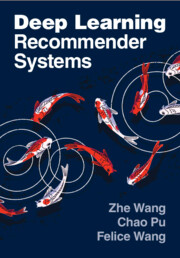Book contents
- Deep Learning Recommender Systems
- Reviews
- Deep Learning Recommender Systems
- Copyright page
- Contents
- Foreword
- Preface
- 1 Growth Engine of the Internet
- 2 Pre-Deep Learning Era
- 3 Top of the Tide
- 4 Application of Embedding Technology in Recommender Systems
- 5 Recommender Systems from Multiple Perspectives
- 6 Engineering Implementations in Deep Learning Recommender Systems
- 7 Evaluation in Recommender Systems
- 8 Frontier Practice of Deep Learning Recommender Systems
- 9 Build Your Own Recommender Systems Knowledge Framework
- Afterword
- References
3 - Top of the Tide
Application of Deep Learning in Recommender Systems
Published online by Cambridge University Press: 08 May 2025
- Deep Learning Recommender Systems
- Reviews
- Deep Learning Recommender Systems
- Copyright page
- Contents
- Foreword
- Preface
- 1 Growth Engine of the Internet
- 2 Pre-Deep Learning Era
- 3 Top of the Tide
- 4 Application of Embedding Technology in Recommender Systems
- 5 Recommender Systems from Multiple Perspectives
- 6 Engineering Implementations in Deep Learning Recommender Systems
- 7 Evaluation in Recommender Systems
- 8 Frontier Practice of Deep Learning Recommender Systems
- 9 Build Your Own Recommender Systems Knowledge Framework
- Afterword
- References
Summary
The introduction of advanced deep learning models such as Microsoft’s Deep Crossing, Google’s Wide&Deep, and others like FNN and PNN in 2016 marked a significant shift in the field of recommender systems and computational advertising, establishing deep learning as the dominant approach. This chapter discusses the evolution of traditional recommendation models and highlights two main advancements in deep learning models: enhanced expressivity for uncovering hidden data patterns and flexible model structures tailored to specific business use cases. Drawing on techniques from computer vision, speech, and natural language processing, deep learning recommendation models have rapidly evolved. The chapter summarizes several influential deep learning models and constructs an evolution map. These models are selected based on their industry impact and their role in advancing deep learning recommender systems. Additionally, the chapter will introduce applications of Large Language Models (LLMs) in recommender systems, exploring how these models further enhance recommendation technologies.
Keywords
Information
- Type
- Chapter
- Information
- Deep Learning Recommender Systems , pp. 48 - 116Publisher: Cambridge University PressPrint publication year: 2025
